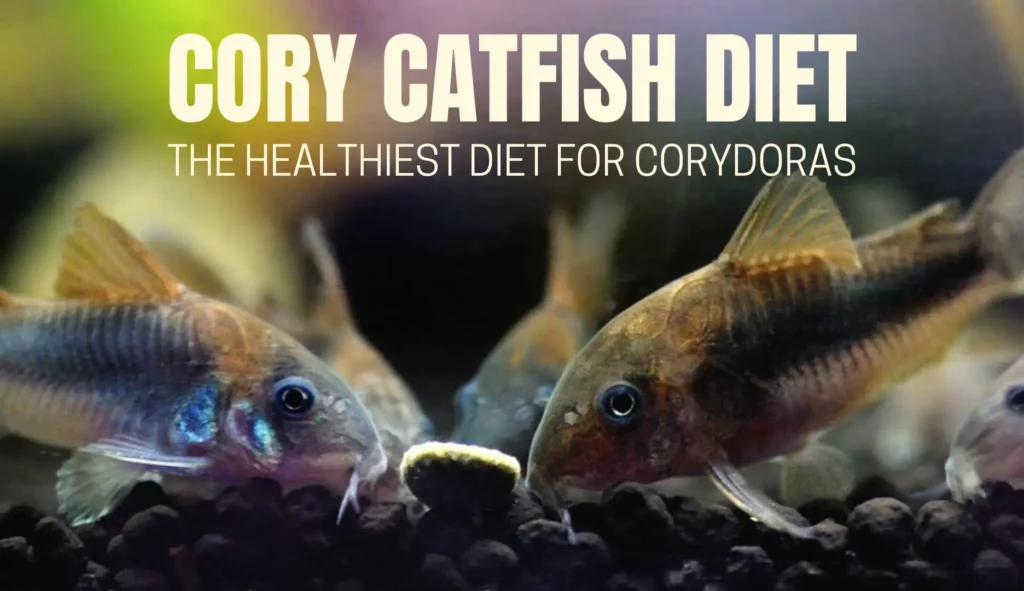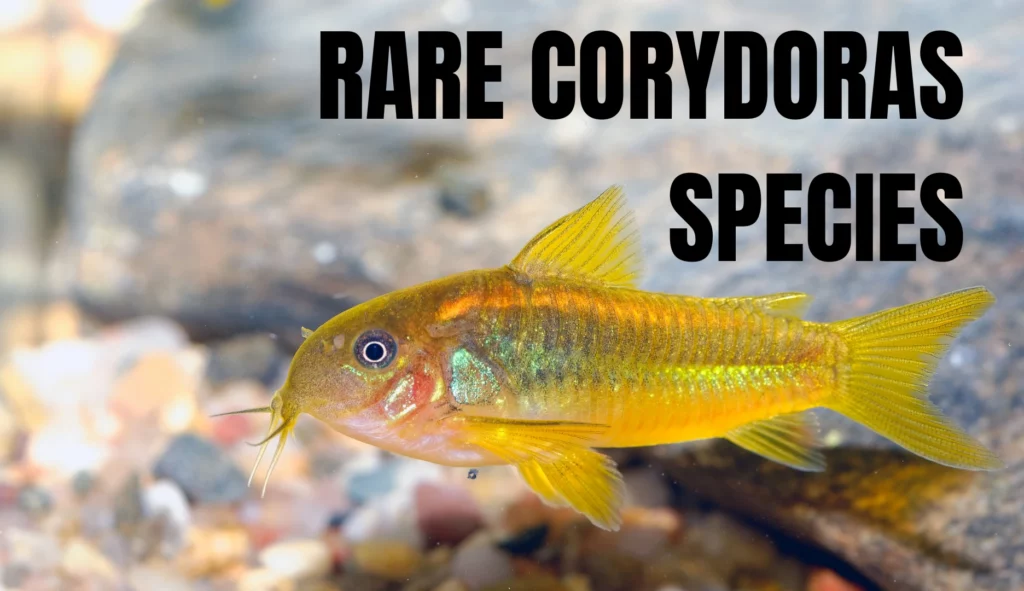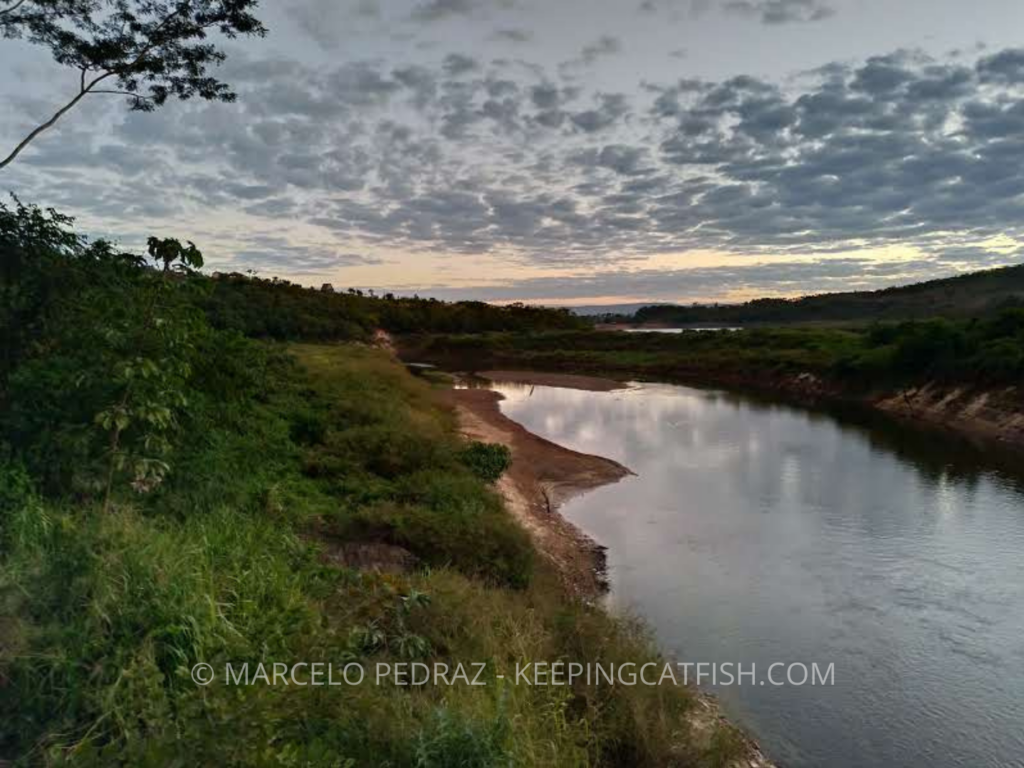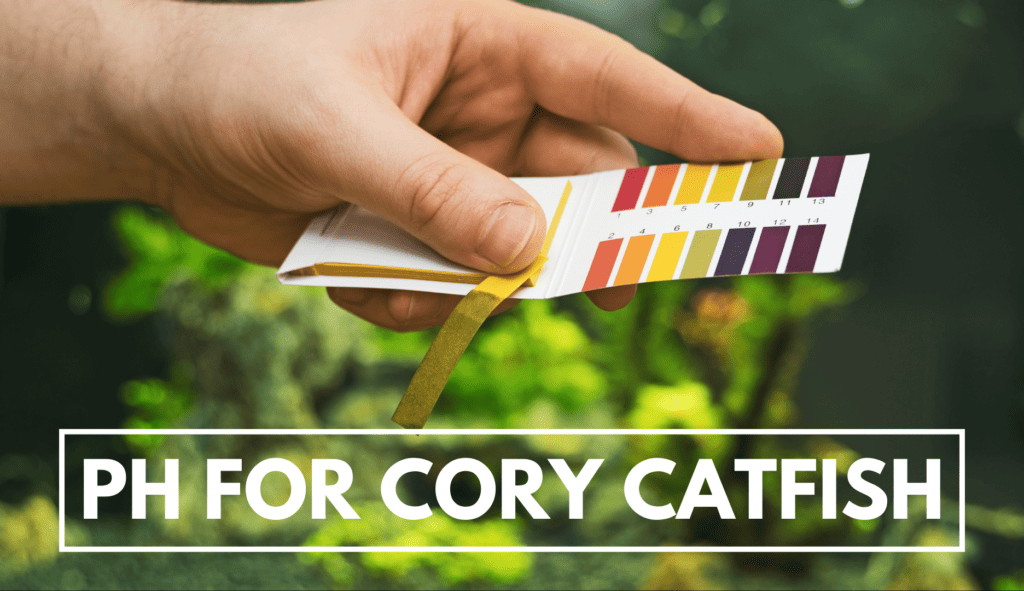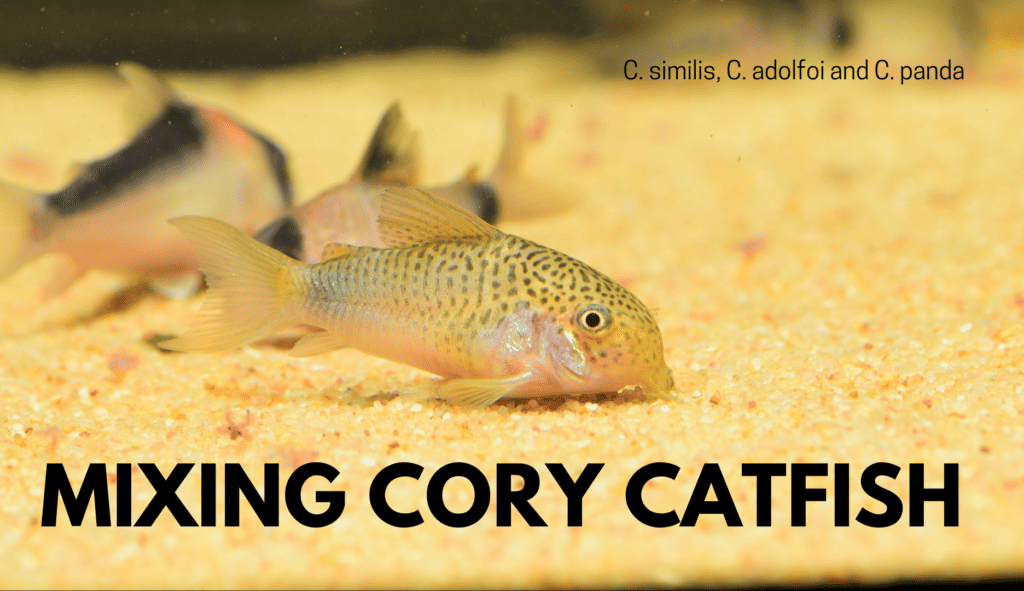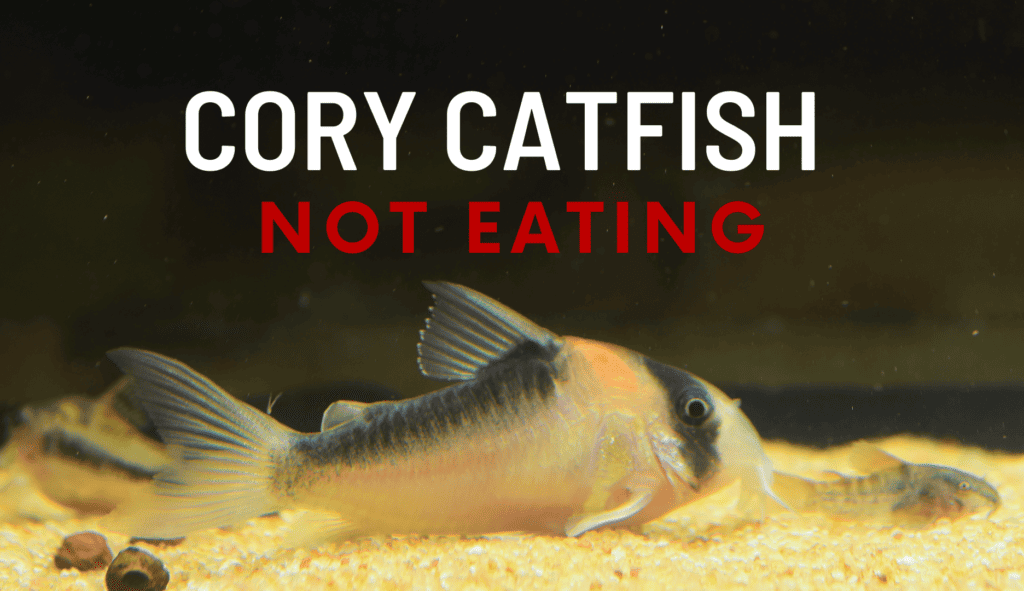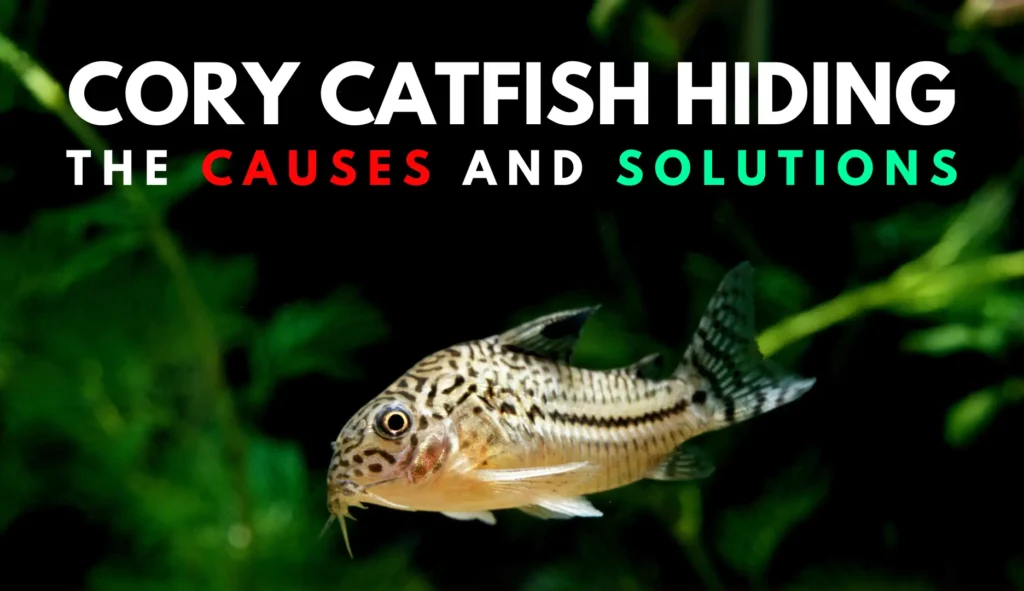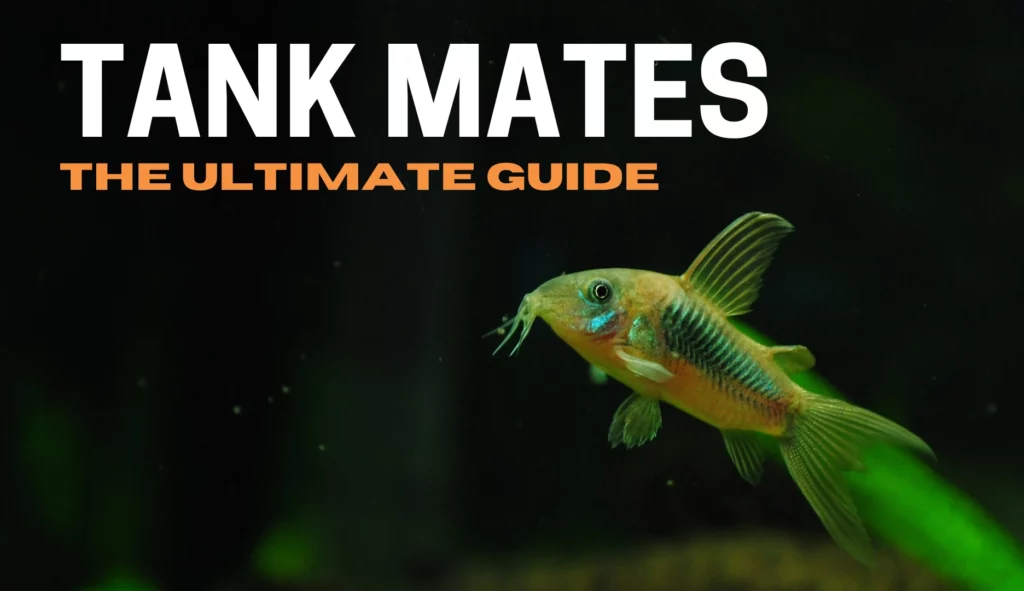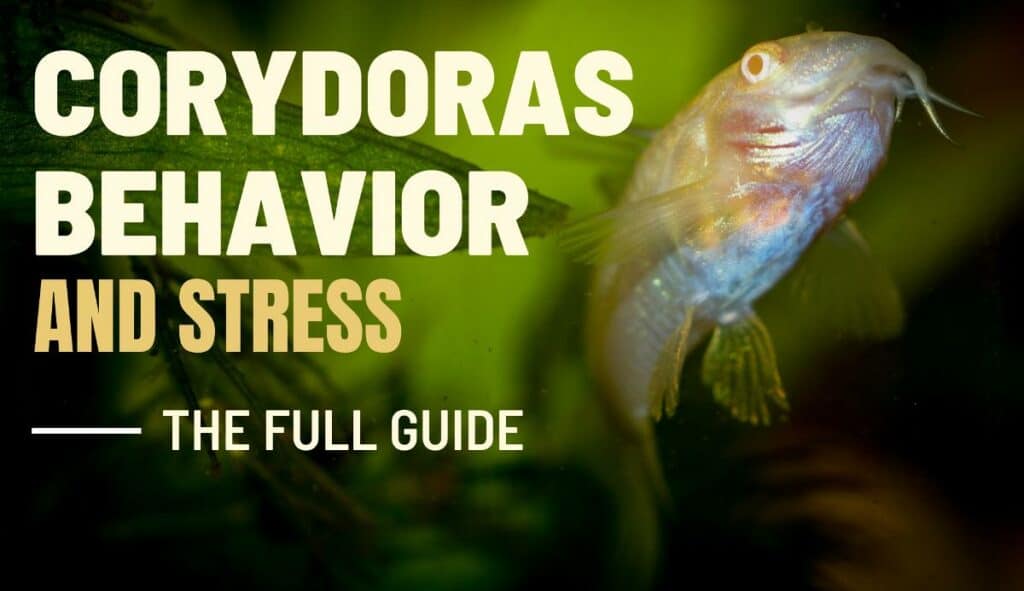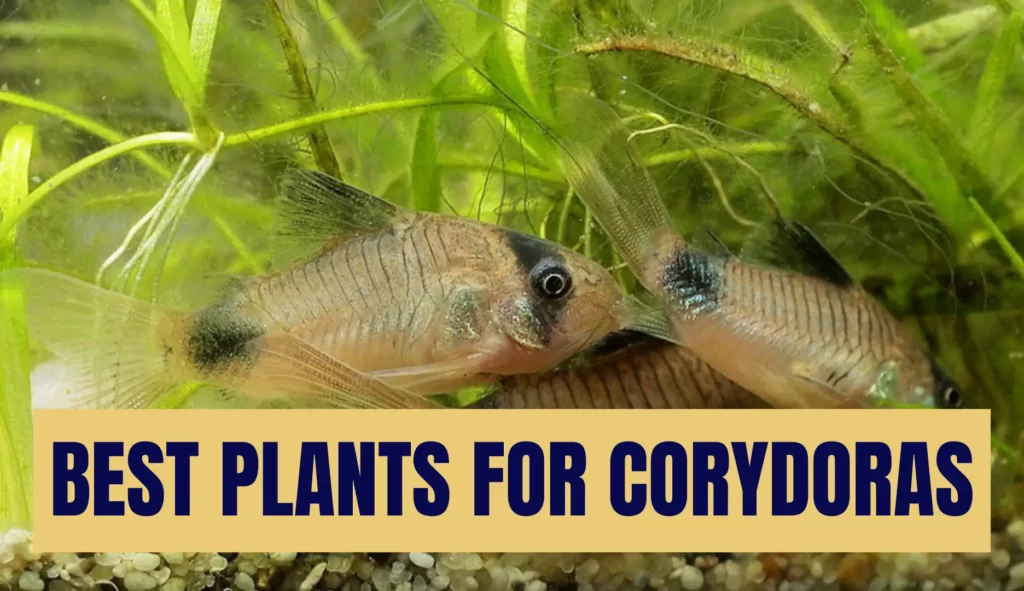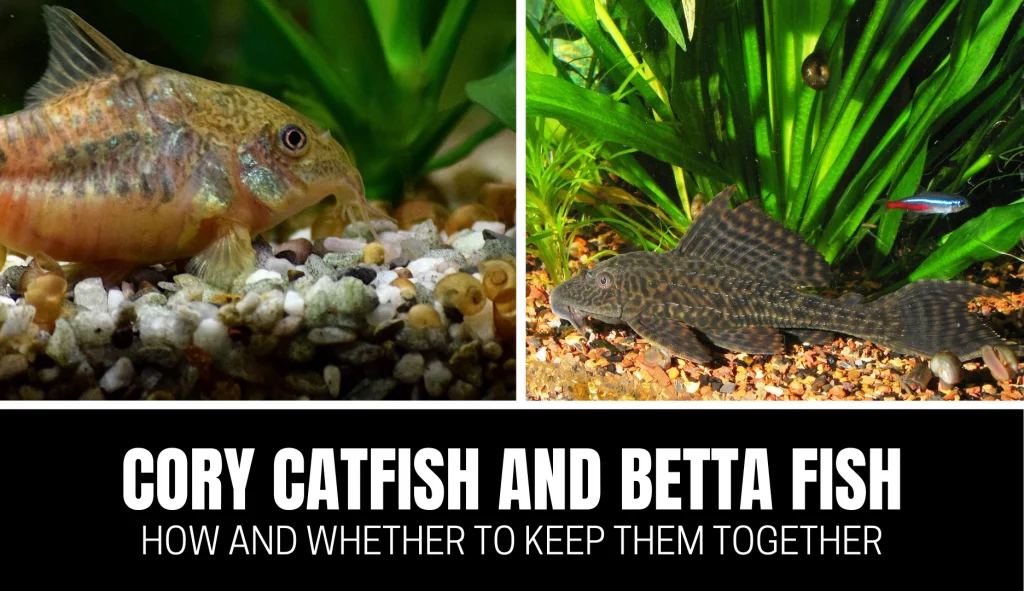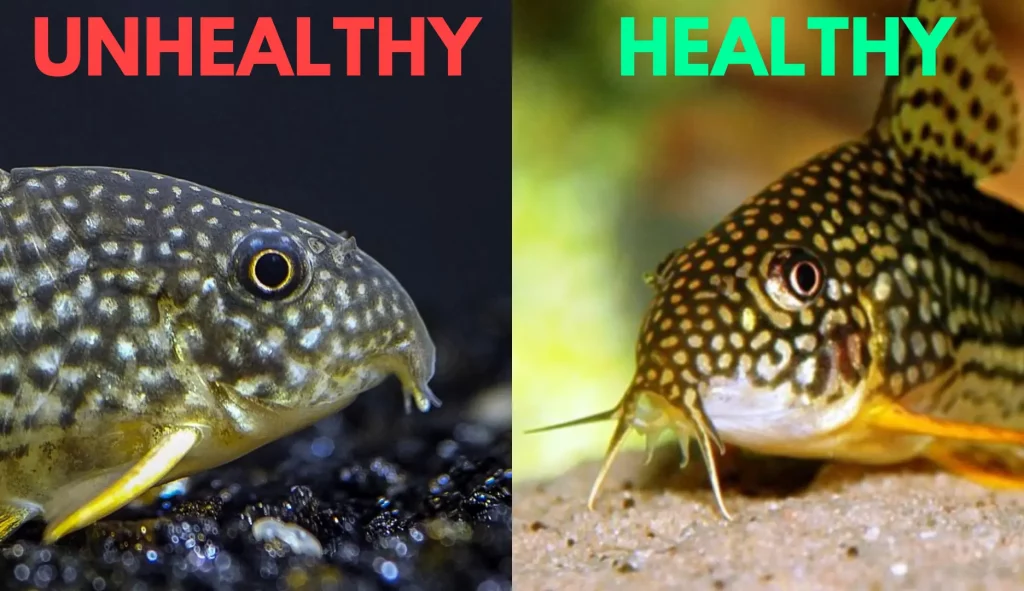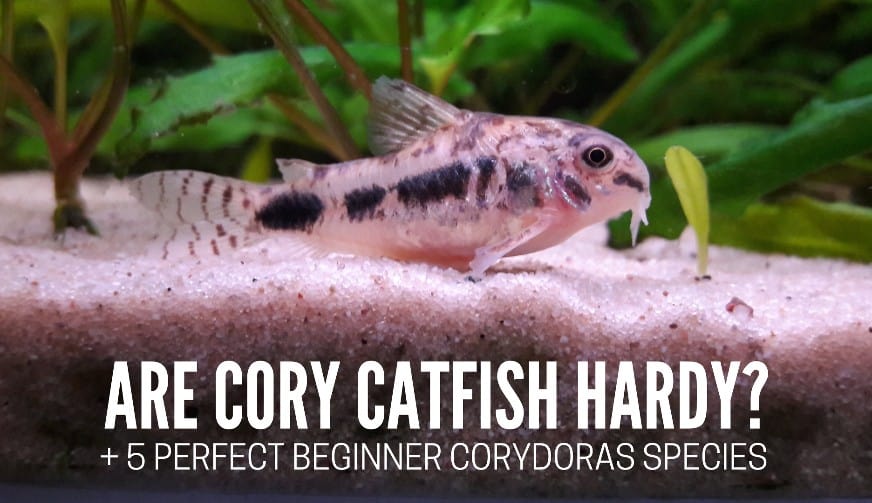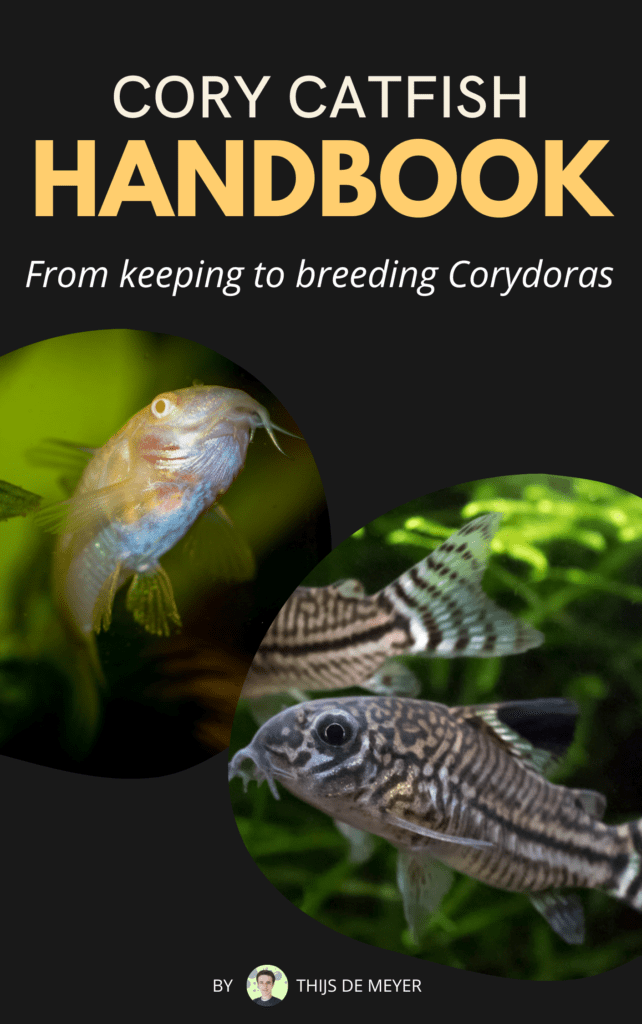Unfortunately, there’s a lot of misunderstanding on what cory catfish eat, or better said, should eat.
This guide covers the ideal diet you can feed your Cories, so they live a long a healthy life.
What do cory catfish eat?
One of the biggest mistakes when keeping cory catfish is thinking that these fish don’t need their own food and that they can survive on leftovers. This will eventually lead to starvation. But what do these fish actually eat?
Cory catfish are mainly carnivorous fish but aren’t picky in terms of what they eat. Corydoras will eat dried pellets and wafers, but also happily eat frozen and live foods. Although they’re not picky, corydoras food should be mainly meat-based and only supplemented with plant-based nutrients.
Corydoras catfish are bottom dwellers that use their barbels to scavenge for food. They love digging in the substrate (which is why sand is the best substrate). Feeding sinking foods is thus very important.
To illustrate how non-picky cory catfish are: these fish will even eat their own eggs when given the chance! So, if you were to breed these guys, make sure to pick out the eggs and withhold them their caviar ;).
Do cory catfish eat algae?
Cory catfish shouldn’t be confused with plecos and don’t eat algae. This is because cory catfish are carnivorous and feed on small insects, larvae, and worms.
Another thing to note is to look at the anatomy of Corydoras sp. Their mouth is made to scavenge and is pointed downwards so they can dig through the substrate. It doesn’t have the capability to scrape off algae/wood.
Let’s compare this to an algae-eating pleco, the most well-known algae eater in the hobby.
Corydoras
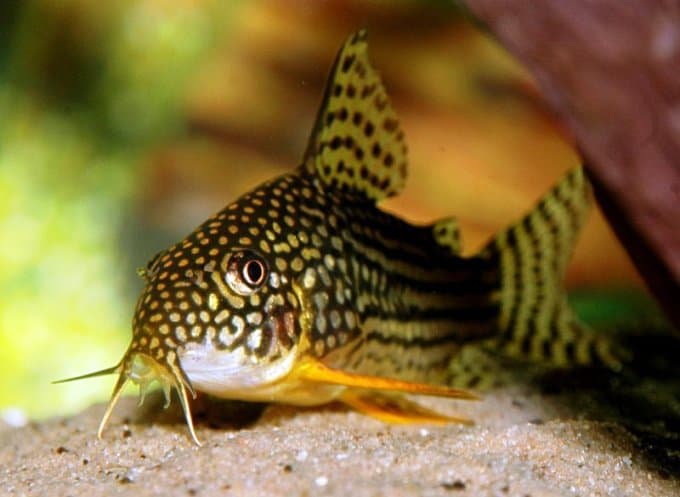
Pleco
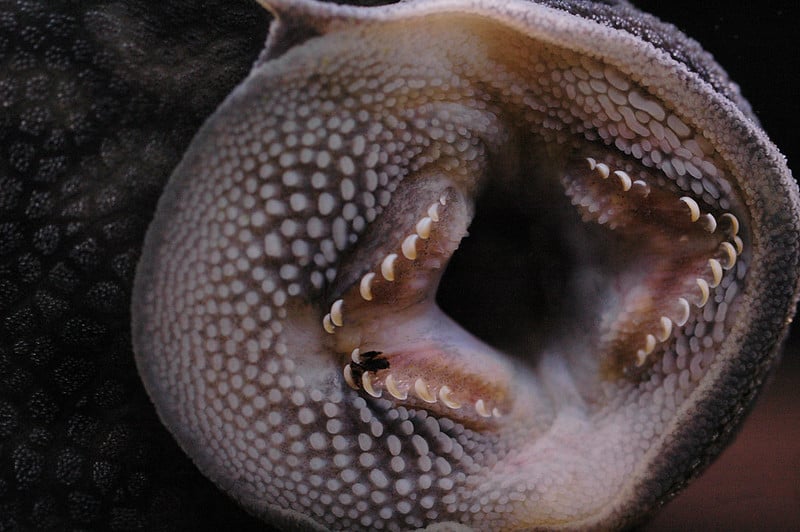
If you’re interested in learning more about this topic, read our full guide right here.
Best types of food for cory catfish
As we’ve discussed, it’s best to feed cory catfish a meat-based diet. Here are the best types of food you can give to your cory catfish.
Live foods
Live foods are as the name suggests, a variety of water critters that are still alive when fed.
This type of food is what cory catfish would eat in the wild and is high in nutritional value. Because this food is alive, it will trigger your cory catfish to display natural behavior. It’s also a great way to incentivize breeding behavior.
However, when feeding live foods it’s extremely important to vary between different foods. This is because live foods are rather unilateral in terms of nutrients. Only feeding one kind of live food may thus cause things like constipation.
Here are some of the live foods I recommend for cory catfish:
Blackworms
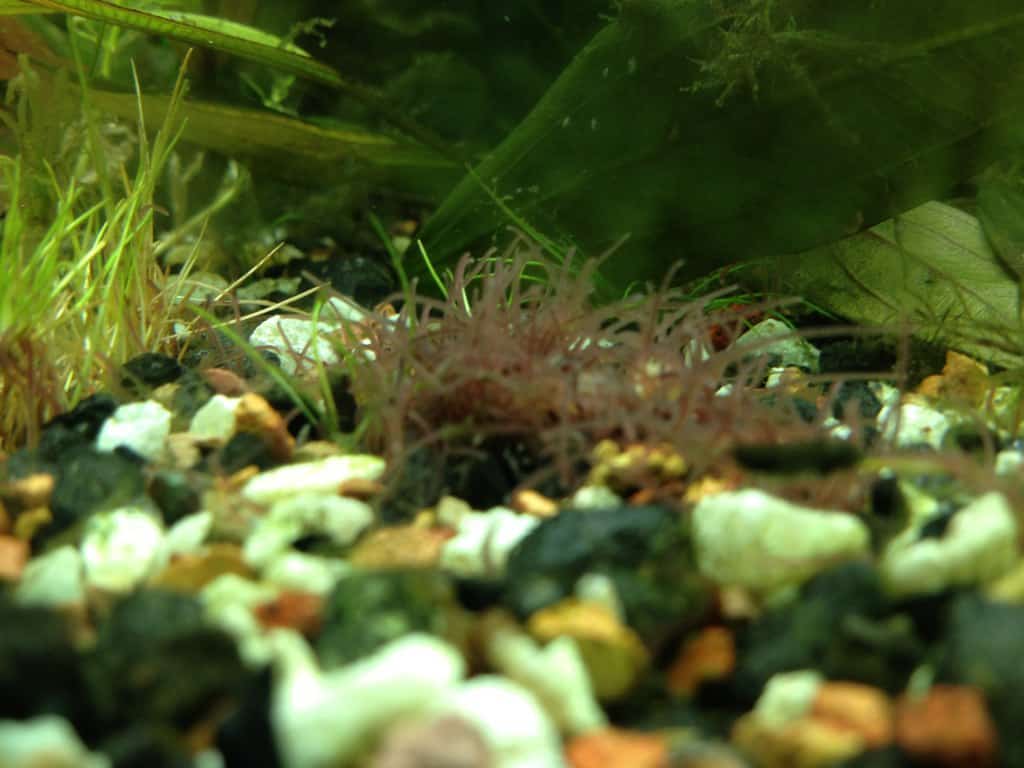
Blackworms are often praised as one of the best live foods for aquarium fish. If you want to get your fish in perfect condition, this food does the job better than any other food.
These worms are high in protein and nutrients and live in freshwater. This means that when feeding them they will survive in your tank, and your cory catfish will have to actively dig for food.
Baby brine shrimp
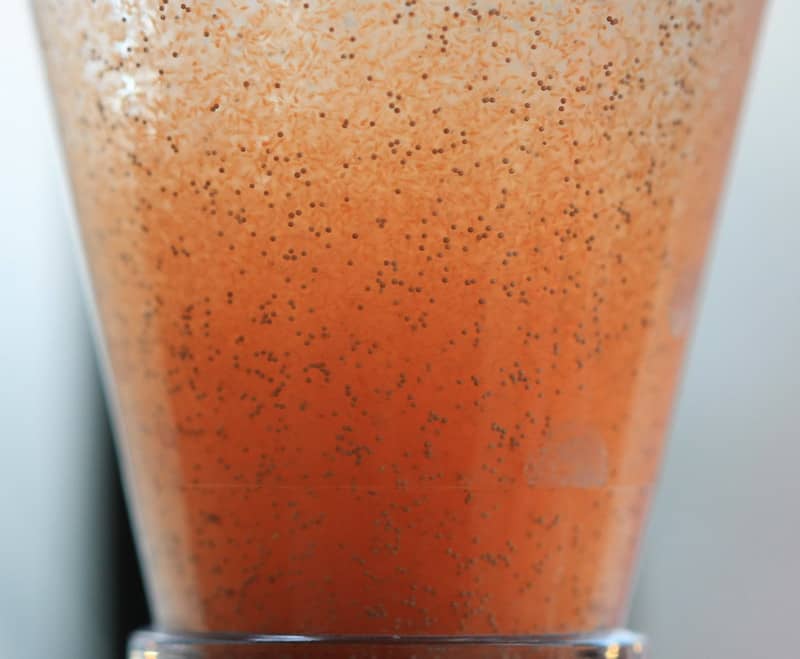
Baby brine shrimp are a superfood. Especially for raising young fish (like cory catfish babies), you won’t get across anything better.
Because these are very small, they don’t make as great of a food source for big cory catfish, but much other small fish will enjoy them.
If you want to feed bbs or Artemia nauplii, you’ll have to hatch them yourself. This makes them a little more work than other types of food. The good thing is that hatching bbs isn’t hard at all: you only need an air pump, some artemia eggs, water and salt.
Grindal worms
Grindal worms are small, white worms that live in non-aquatic environments. they’re high in protein and nutrients, making them another great food source for Corydoras.
They also sink to the bottom, so your cory catfish won’t have a hard time picking them up.
Dried foods
Even though live foods are the best food for cory catfish, they require more effort and cost a lot more. Luckily, the quality of dried foods has significantly increased making it a very worthy food for your catfish.
A benefit of dried foods is that they are a lot more varied in terms of nutrients than live and frozen foods.
Pellets and wafers are the best type of dried food for cory catfish because they directly sink to the bottom. Don’t buy flakes, because they float.
When deciding what dried foods to pick, it’s important to pick a type without a lot of fillers. These fillers are low in nutritional value and can cause bloat. Examples of fillers are wheat, corn and soy. Almost all fish foods will have fillers in them, but it’s about minimizing the quantity.
Here is my favorite type of pellets for cory catfish:
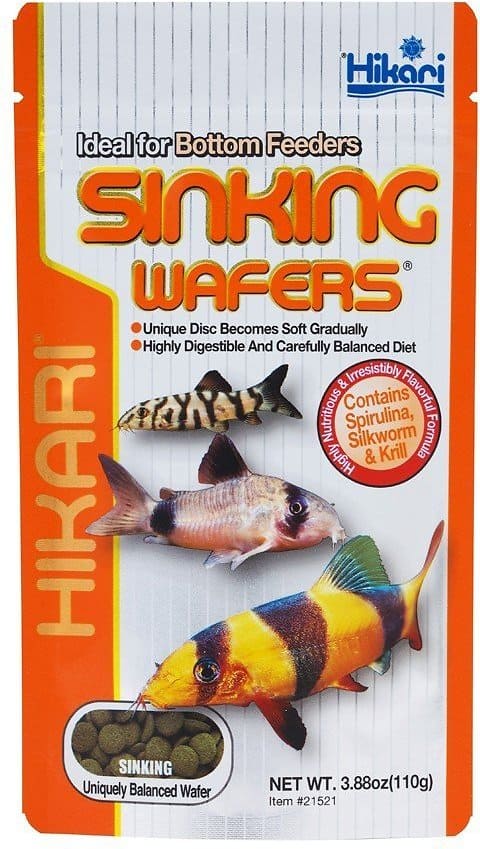
Hikari sinking wafers are specifically developed for cory catfish and loaches. It’s high in protein, vitamins, and minerals providing making it a healthy option.
It also has some plant-based materials like spirulina, optimal as a supplement for the meat-based nutrients in this food.
Frozen foods
Frozen foods are live foods that are killed and frozen. they are cheaper and more convenient than live foods.
Frozen foods come in so-called blisters:
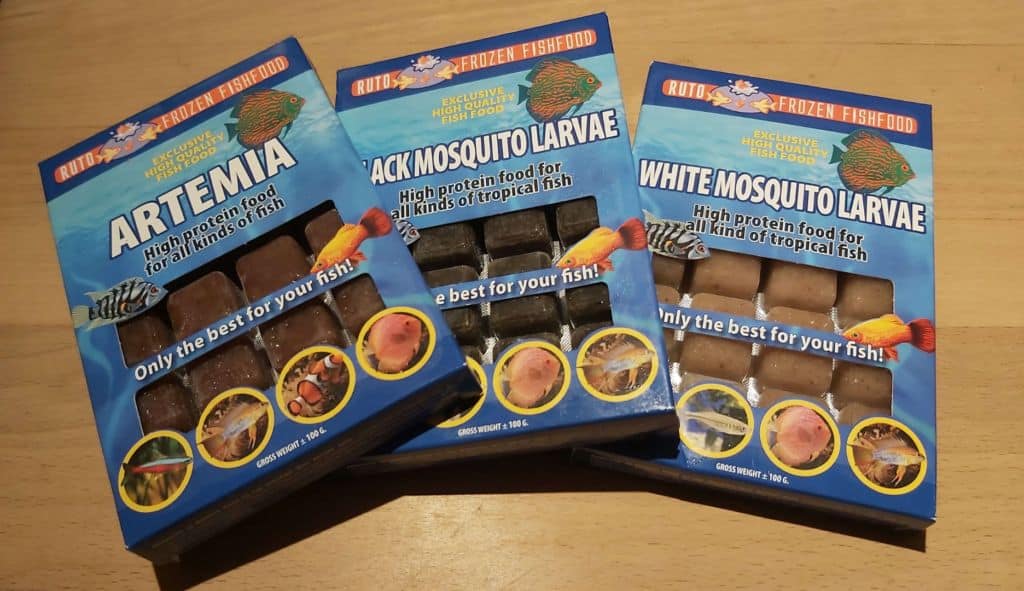
Depending on how many fish you have, you can pick out a small block and put it in your tank.
I like frozen foods because I know for sure what I am feeding. We’ve discussed dried foods and all the cheap stuff and conservatives they put into some of those pellets. Frozen foods will also be more likely to get eaten by wild-caught fish that have a hard time eating processed foods.
If you want to feed frozen foods, it’s also essential to vary between different types of foods, so that your fish get all the nutrients they need.
I recommend defrosting the block before putting it in the tank. Otherwise, the fish in the upper layer will eat most of it, and hardly any food will reach the bottom.
Gel foods
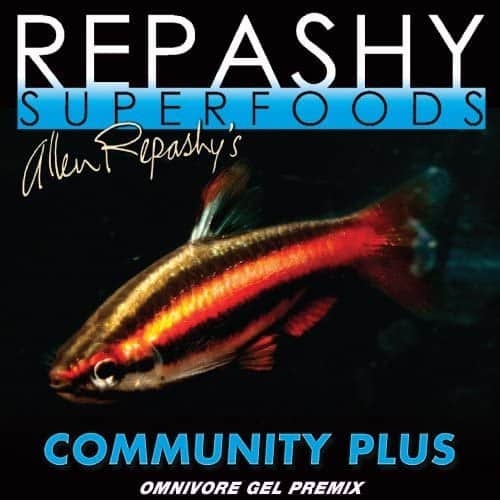
Lastly, one of my favorite types of food if I want to give my fish an extra boost. Perhaps to breed them or make them grow fast.
Gel foods are foods that come in the form of a powder, and upon adding boiling water, turn into a solid/gel mass that you can feed to your fish.
The gel blocks will sink to the bottom of the tank and stay intact for many hours. This way, you will have hardly any problems with food polluting the water.
Repashy is one of the most well-known and highest-quality gel foods available. For cory catfish, community plus is the best choice.
How often to feed cory catfish
It’s recommended to feed your cory catfish one to two times a day. The amount of food should be eaten in less than 10 minutes, or you are feeding too much.
It does depend on what goals you have with your cory catfish. If you plan on breeding them or want to make young fish grow fast, it’s a good idea to feed more.
1. Raising cory catfish babies
The younger the fry is, the more frequently it should be fed. I always tell people, the more the better.
This is because if you feed small quantities throughout the day, the fish will take in more nutrients than if you were to provide all this food at once.
For cory catfish fry, I recommend feeding at least 2 times a day, but even better is 3-4 times a day.
If you want to know more about cory catfish fry, I highly recommend reading our full article. Click here.
2. Conditioning cory catfish
Conditioning cory catfish is the process by which we will prepare the fish for breeding. The most crucial part of conditioning the fish is feeding them many high-protein foods, which incentivizes the females to produce eggs.
In this case, it’s very useful to feed small quantities throughout the day. We’ve discussed the different types of food you can give, so vary between different options. 2-3 times is optimal for conditioning. But actually, you can feed as often as you want as long as you decrease the quantity per feeding so that you don’t overfeed your fish.
How long can cory catfish go without food?
Cory catfish are quite tough fish, which can last quite some time without food.
A healthy adult cory catfish can survive 2-3 weeks without food. If you have a big tank, it might be able to survive way longer by eating small organisms in the ecosystem.
Young cory catfish (faster metabolism) and sick cory catfish will starve way more easily. It’s important to feed your cory catfish a balanced diet to ensure it has a built-up reserve.
Do cory catfish eat vegetables?
In the wild, cory catfish scavenge for small invertebrates and their diet consists of larvae and water critters. They will also eat dead flesh from other fish and are known to eat their own eggs.
Cory catfish do not eat vegetables and are mainly carnivorous. They also aren’t able to bite off pieces of vegetables like plecos with their mouth.
Spirulina
Spirulina is a biomass that’s derived from the cyanobacteria (blue-green algae). It is packed with a lot of useful vitamins and minerals.
Even though cory catfish don’t eat algae and plant-based foods aren’t a part of their desired diet, I believe spirulina is a useful addition to their diet because of the minerals and vitamins. Feeding it once or twice a week is a good idea.
There are a lot of fish pellets that have spirulina in them, such as Sera Viformo (a good food for cory catfish), but you can also buy spirulina tablets.
Healthiest diet for cory catfish fry
We’ve now talked mostly about all the foods for adult or juvenile cory catfish, but if you’re ever planning on breeding cory catfish, here are the foods I recommend that make your fry go super fast.
Stage 1: Vinegar eels/microworms
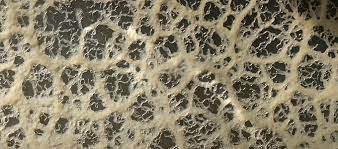
For the first 48 hours of their lives, cory catfish fry will live off their yolk sack. You must not feed the fry in this stadium, because it will not get eaten and decrease the water quality.
After these 48 hours, I recommend feeding vinegar eels or micro worms. Whichever you prefer. Both are around 1mm in size and will make for a great first food.
Stage 2: Baby brine shrimp
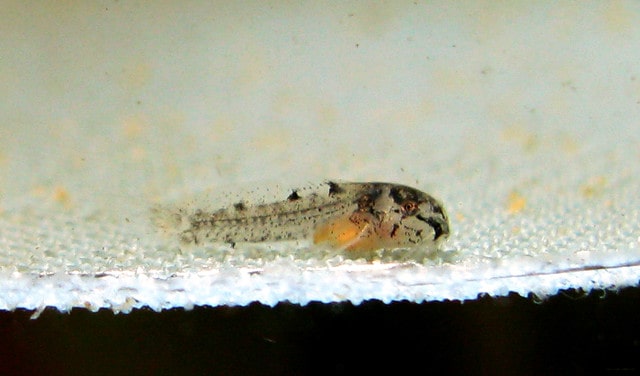
Baby brine shrimp (BBS) are the single best food for cory catfish fry, but actually for almost any type of baby fish. They’re not challenging to culture (although it does require some work), and are highly nutritious.
You can feed baby brine shrimp as long as you want, but when your cory catfish get bigger they will have a harder time finding these small creatures.
Stage 3: Grindal worms & other foods
When your fry is around 0.5 inches, I recommend starting to give other foods along the BBS. You can basically give any food you’d give adult fish, but sticking with highly nutritious live foods supercharges growth.
Grindal worms are white worms that are high in fat and protein, which makes them great for young fry. Other foods you might give are live mosquito larvae, bloodworms, and Repashy. Repashy is my favorite prepared food. They have a special formula for raising fish fry. Link to Amazon.
Conclusion
Cory catfish are mainly carnivorous fish that aren’t so picky in what they eat. But the healthiest diet is a meat-based diet of high-protein foods supplemented with some spirulina.
Here is the healthiest diet for cory catfish:
Live foods – This is the best type of food due to its high nutritional value. Live mosquito larvae, bloodworms, and especially blackworms are great. The best food for conditioning cory catfish to spawn. Variation is very important.
Dried foods – This is the most accessible food and easiest to feed. A benefit opposed to live and frozen foods is that they’re more balanced in terms of nutrients. With dried foods, it’s important to select a sinking food that’s high in nutritional value. The cheapest options in Walmart, Petco, etc. are often stuffed with fillers. My favorite are Hikari sinking wafers and Viformo.
Frozen foods – Frozen foods are frozen (dead) live foods. You can get basically any live food in this form. Again, variation is key or your cory catfish will get an overdose of certain nutrients and a shortage of others.
Gel foods – This comes in a powder and upon adding boiling water it becomes a coherent gel. This is my favorite overall. Repashy is very easy to prepare and high in nutritional value. My cory cats love it. Two of my favorite formulas are Spawn and Grow (link to Amazon) and Community Plus (link to Amazon).
A big misconception is that cory catfish eat algae or vegetables. This is not true. Spirulina is a useful addition to their diet, though as it contains a lot of vitamins and minerals.
For adult fish, feeding around one to two times a day is optimal. If you want to condition them for breeding, you can increase to three times a day.
A healthy adult cory catfish can go without food for two-three weeks.
Corydoras fry diet
The single best food for cory catfish fry is baby brine shrimp (BBS). When the fry has just hatched, start by feeding vinegar eels or micro worms. After a week or so, start feeding the BBS)
When the fry is 1/2 inch in size, start feeding chopped-up live foods like grindal worms and blackworms as this will make the fry grow the fastest.

